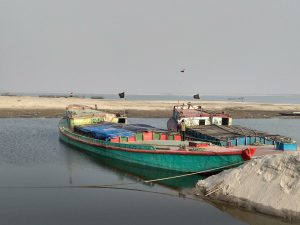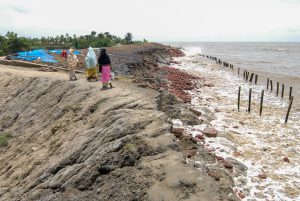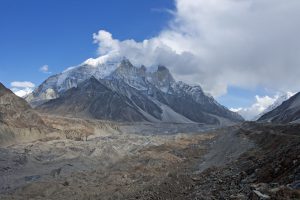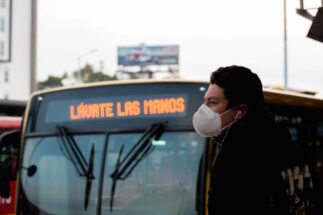On May 25, a barge carrying 800-900 tonnes of fly ash from West Bengal to Bangladesh sank in the Hatania-Doania River at the edge of the Sundarbans. Fly ash is the toxic residue left after coal is burnt.
This is the fifth time since March 2020 that a barge laden with fly ash has capsized along routes used to export the material from India to Bangladesh. The routes include National Waterway 1 (NW-1, along the Ganga), National Waterway 97 (NW-97, in the Sundarbans) and the Indo-Bangladesh Protocol (IBP) routes.
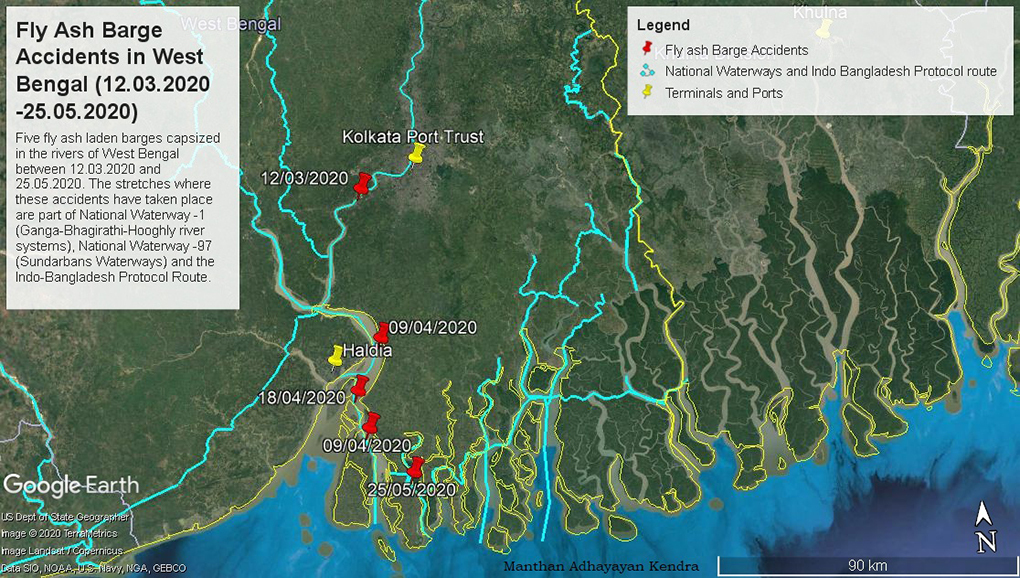
Fly ash is exported from coal-fired power plants in India to Bangladesh, where it is used to make cement. Most comes from West Bengal, transported by barges on the network of rivers connecting the two countries.
“On an average, 7-10 capsizes have happened every year along the protocol route in the past five years,” said Sheikh Rokon, secretary general of Riverine People, a Dhaka-based NGO. “I have not heard of any clean-up or recovery effort… the vessels are abandoned because rescue operations cost more than the vessel itself.”
Fly ash contains heavy metals that can cause severe contamination of water bodies.
In 2016 a committee set up by the National Green Tribunal (NGT), India’s environmental court, assessed the environmental impacts of fly ash pollution on Ennore creek and areas surrounding North Chennai Thermal Power Station. It found heavy metals like lead, mercury and copper at levels above the safe limit in samples of fish, crab, prawn, oyster and mussels. The experts said fly ash deposition also caused habitat loss, including the reduction of mangroves.
The environmental impact of capsizes aside, transportation activities are harmful too.
“What we have is the transport of a substance that is highly toxic in open conditions in river systems that have high levels of biodiversity and livelihood dependence,” said Ritwick Dutta, an environmental lawyer and founder and managing trustee at the NGO Legal Initiative for Forest and Environment (LIFE).
Dutta noted that studies have established that fly ash contains up to 100 times more radiation than a nuclear power plant producing the same amount of energy. “This fact was also recorded in an NGT judgement in 2011,” he added.
![Fly ash blows into the air due to faulty pipes [image courtesy: Legal Initiative for Forest and Environment]](https://dialogue.earth/content/uploads/2020/06/pipes_in_fly_ash_barge_credit_LIFE.jpg)
Most of the barges used to transport fly ash are Bangladeshi, Rokon said. Asked why so many barges sink, Rokon mentioned irregular and low water levels in the rivers, use of old, worn-out vessels, and lack of route maintenance and overloading. The barge that sank on May 25, which was Bangladeshi, foundered after hitting a submerged jetty.
Route maintenance mainly involves dredging, which has adverse impacts on biodiversity.
Read: What use is dredging the Brahmaputra?
Dutta said barge owners are legally liable for capsizes, even if they happen due to events such as storms that are beyond the owners’ control. He referred to a principle called ‘no fault liability’. For example, he explained, if a dam breaks because of an earthquake, the builder is still responsible because the destruction was due to the building of the dam. Dutta said that ‘no fault liability’ would apply to barge owners that are not Indian if a barge capsizes in Indian territory.
The Third Pole asked the Inland Waterways Authority of India (IWAI), West Bengal Pollution Control Board and the West Bengal Forest Department about accountability with respect to the sinking of the barges and clean-up efforts, given that the cargo is toxic. They were also asked if it is prudent to allow movement of toxic cargo in eco-sensitive areas. This report will be updated if and when a response is received.
Transport of fly ash from India
“Export of fly ash from India [to Bangladesh] is a fairly recent development and is an outcome of the trade agreement between India and Bangladesh,” Dutta explained. Most of the export has taken place in the past five years, he said.
The India-Bangladesh Protocol on Inland Water Transit and Trade was signed in 2009 under an agreement to facilitate trade and commerce between the two countries. It was updated in 2015.
Read: Another shipping disaster in the Sundarbans
There are six main routes under the Indo-Bangladesh Protocol (IBP) now. Apart from the Ganga and the Sundarbans, they include routes to north-east India through Bangladesh.
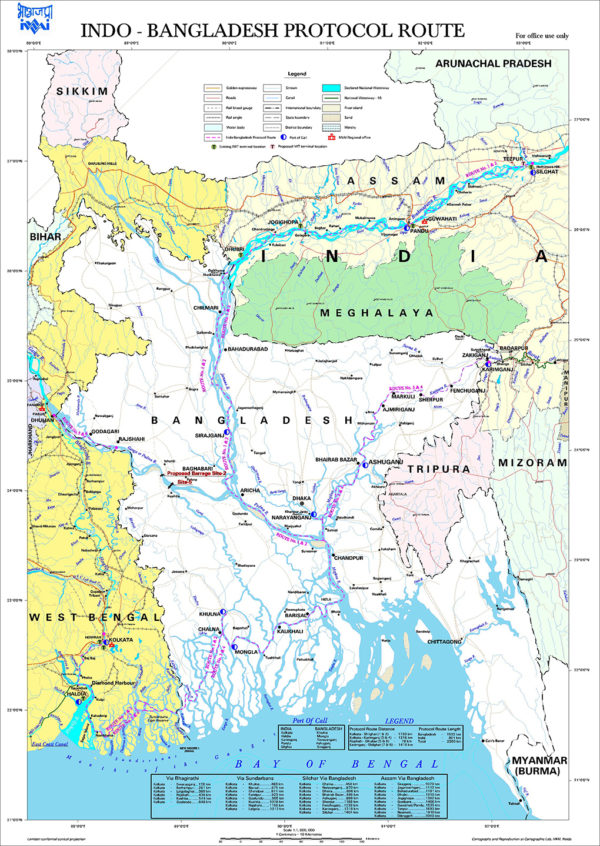
“Of all the cargo moved on the Indo-Bangladesh Protocol route, 97% is fly ash,” said Avli Verma, a researcher Manthan Adhyayan Kendra, an organisation that studies water and energy policies. According to a 2019-20 IWAI report, fly ash accounts for 10% of the traffic of all the national waterways.
Verma said movement of fly ash along these routes picked up after the protocol was renewed in 2015 in line with a trade agreement.
Even this April, when India was under a strict lockdown due to the Covid-19 pandemic, 212,898 tonnes of fly ash was transported along IBP routes.
The routes include NW-97, which has 14 stretches through the Sundarbans – the world’s largest mangrove forest that straddles India and Bangladesh. The area contains a national park and a tiger reserve which are protected under the Wildlife Protection Act, 1972 and is also a UNESCO World Heritage Site.
Demand and supply of fly ash
Rokon said there is high demand for fly ash in Bangladesh because “hundreds of cement factories are coming up” in the country. “We don’t have many coal plants and we are dependent mostly on India for the fly ash.”
The fly ash being exported to Bangladesh is from thermal power plants in West Bengal – including Farakka, Triveni, Budge Budge and Haldia, according to Kankana Das, an analyst at LIFE.
In the best-quality coal, “for every kilo[gram] of coal burnt, 340 grams of ash is produced,” Dutta said. “The kind of coal we generally use has around 40-50% ash content and this becomes a liability that has to be transported.”
The steel and aluminium industries also produce a lot of fly ash, which is transported to ports like Haldia for export to Bangladesh, Dutta said.
In 2016, India’s Ministry of Environment Forest and Climate Change (MoEFCC) mandated that 100% of fly ash should be used. However, export also qualifies as utilisation. “The law does not specify utilisation [of fly ash] by the producer,” Dutta said.
More cargo down the Ganga
In February 2018, the IWAI signed an agreement with the World Bank for a riverway project called Jal Marg Vikas that will increase the capacity of NW-1 at a cost of INR 53.69 billion (USD 704.76 million). The project is expected to be completed by March 2023.
Read: India’s national waterways: what are the impacts on rivers, ecology and livelihoods?
Once that happens, barges carrying 1,500-2,000 tonnes will use this route, Verma said. The maximum capacity now is 750 tonnes.
In theory, riverways provide the cheapest and most environmental-friendly mode of transport, especially of bulk cargo. But that assumes strict implementation of pollution-control laws, including quality checks on vessels that carry toxic cargo such as fly ash.
![<p>A barge carrying coal to a power station moves upstream on the Hooghly in Kolkata. Many similar barges carrying flyash downstream have capsized in the waterways of India and Bangladesh [image by: Joydeep Gupta]</p>](https://dialogue.earth/content/uploads/2020/06/for-barge-sinking-story.jpg)
